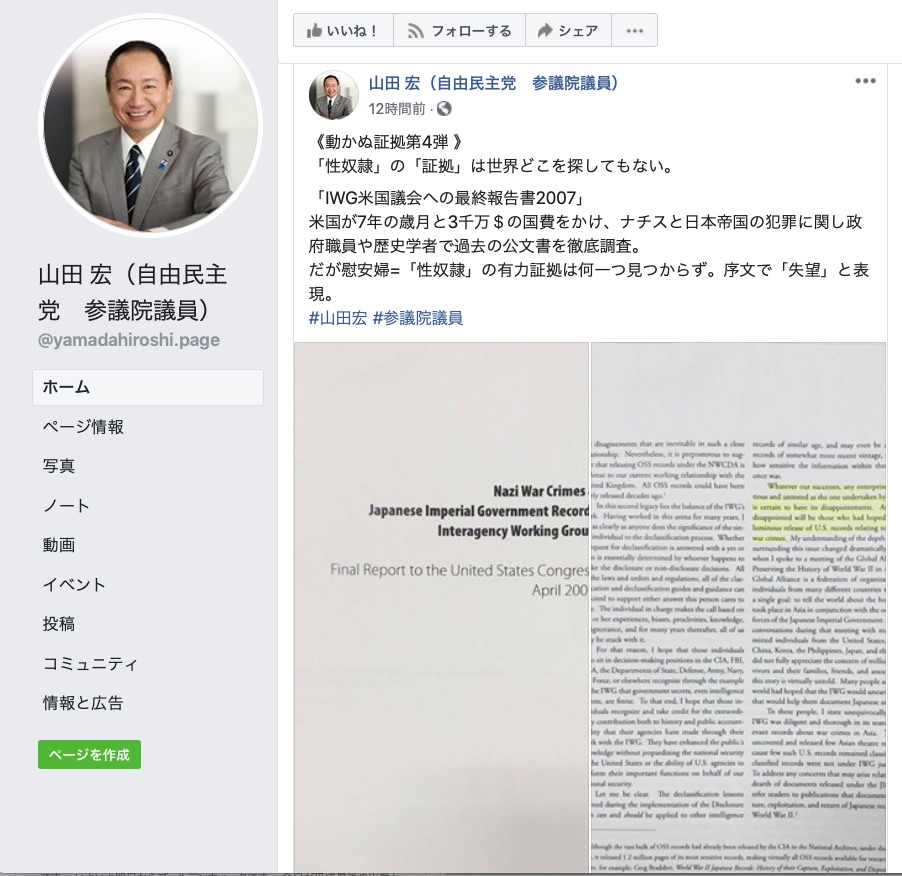米議会報告に関するフェイクニュース
自民党の山田宏参議院議員が5月8日にフェイスブックに慰安婦が性奴隷だった証拠はないとの投稿を掲載しました。
《動かぬ証拠第4弾 》
「性奴隷」の「証拠」は世界どこを探してもない。
「IWG米国議会への最終報告書2007」
米国が7年の歳月と3千万$の国費をかけ、ナチスと日本帝国の犯罪に関し政府職員や歴史学者で過去の公文書を徹底調査。
だが慰安婦=「性奴隷」の有力証拠は何一つ見つからず。序文で「失望」と表現。
#山田宏 #参議院議員

山田議員がいう報告書は確かに存在し、インターネットで公開されています。そのタイトルは「Nazi War Crimes & Japanese Imperial Government Records Interagency Working Group
Final Report to the United States Congress April 2007」。(報告書はこちら)
結論から言うと、山田議員の指摘は間違っています。すでにこの指摘を真実と信じ込んでいる人もみられたので、以下にその理由を記します。
投稿には報告書の写真が2枚掲載されています。一枚が表紙で、もう一枚は山田議員が根拠とする文章があるページです。該当部分に蛍光ペンで印がつけられています。以下の文がその文と日本語訳です。
Whatever our successes, any enterprise as ambitious and untested as the one undertaken by the IWG is certain to have its disappointments. Among the disappointed will be those who had hoped for a voluminous release of U.S. records relating to Japanese war crimes.
我々の成果がなんであれ、IWGが請け負ったものと同じくらい野心的でまだ真価が問われていない事業は失望するのは確実です。失望する人の中には、日本の戦争犯罪に関連するアメリカの記録が大量に公開されるのを望んでいた人たちがいるでしょう。
(訳注 IWG/この調査を行ったワーキンググループ)
この引用が奇妙だということには、すぐに気がつきます。文の量が少なすぎますし、文章が結論部分らしくない感じがするからです。
実際、この文章は結論部分ではなく序文(preface)に書かれていました。普通、序文には報告書の結論は書きません。
報告書を引用するのなら結論部分(findingやconclusion)からにするのが普通であり、それが主張を根拠あるものとするものです。
見てのとおり、文には慰安婦が存在した証拠はないとは書いていません。「戦争犯罪」と書いてあるだけで、慰安婦という言葉は登場しません。戦争犯罪の中には性奴隷は含まれますから、もしかすると、そのことを指しているのかもしれません。
では、「性奴隷(sex slave)」という言葉が登場するかを調べるために報告書の全体を検査しました。見つかったのは、たった1件でした(p20)。
However, mistreated POWs, sex slaves (the so-called “comfort women”), civilian internees, and forced laborers remained dissatisfied with the extent of compensation—if any—for their suffering.
しかし、虐待された戦時捕虜、性奴隷(いわゆる慰安婦)、民間人の非抑留者と強制労働者たちは、あったとしても、苦痛に対する補償の程度に不満なままです。
性奴隷の事実関係をテーマとした議会報告書で、「性奴隷」という言葉が一回しか登場しないとはかなり考えにくいことで、それは性奴隷がこの報告書のテーマではないことを強く暗示しますし、なにより、この文は性奴隷が存在していたことを認めていると解釈できます。
念のために、「慰安婦(comfort woman)」でも検索しました。複数形で書かれていると検索できないので「comfort」のみで検索しました。すると、「comfort woman」に該当する言葉は、先の文のほか3件が見つかりました。(p20、p21、p27)
p20の部分は日本の戦争犯罪に関する戦後の動きを解説した章の中にあります。
In the 1990s, no fewer than 16 measures dealing with Japanese war crimes were introduced in the Congress in attempts to secure some sort of redress for victims. For instance, in 1997 a joint resolution was introduced in Congress that expressed a number of groups’ frustration with the stance of the United States and Japanese governments with respect to Japanese accountability for war crimes committed by Imperial Japan. House Concurrent Resolution 126 sought to express the sense of Congress concerning war crimes committed by the Japanese military during World War II. After listing particular offenses, characterized as “atrocious crimes against humanity,” the resolution called on Japan to
(1) formally issue a clear and unambiguous apology for the atrocious war crimes committed by the Japanese military during World War II; and
(2) immediately pay reparations to the victims of those crimes, including United States military and civilian prisoners of war, people of Guam who were subjected to violence and imprisonment, survivors of the “Rape of Nanjing” from December, 1937, until February, 1938, and the women who were forced into sexual slavery and known by the Japanese military as “comfort women.”
1990年代に、犠牲者のためにある種の補償を確保しようとして日本の戦争犯罪を扱う16件もの法令が議会において提起されました。1997年に、大日本帝国が行った戦争犯罪についての日本の説明責任に関して、多くのグループの合衆国と日本の姿勢への不満を表明した両院合同決議が議会に提起されました。下院の合同決議第126は第二次世界大戦中に日本軍が犯した戦争犯罪を懸念する議会の意見を表明することに努めました。特定の犯罪をあげて、「人類に対する法外な犯罪」と特徴づけたあとで、決議は日本に以下を要請しました。
(1)第二次世界大戦中に日本軍が行った非人道的な戦争犯罪に対して公式に明確で一義的な謝罪を出すこと。
(2)合衆国の軍隊と民間人の戦時捕虜、暴力と投獄の対象となったグアムの人々、1937年12月から1938年2月までの「南京の強姦」の生存者、性奴隷を強いられ、日本軍に「慰安婦」として知られた女性たちを含む、こうした犯罪の犠牲者に直ちに賠償金を支払え。
このように、米下院が慰安婦を性奴隷と認識していることが明確に記されています。
p21の部分は先と同じ章の中にあり、やはり慰安婦の存在を認める内容です。
Additional suits were filed and in preparation for Japanese courts seeking redress for “comfort women,” slave laborers, and other victims of Japanese crimes, all of whom demanded a Japanese apology and compensation from Japanese courts.
さらなる訴訟が性奴隷の「慰安婦」と日本の犯罪のその他の犠牲者への補償を求めて日本の法定で提訴され、準備されていて、それらすべては日本の謝罪と補償を求めました。
p27の部分は調査グループのIWGが各省庁に指示した、特に注目すべき5項目の犯罪リストの中の一つです。
・the so-called “comfort women” program—the Japanese systematic enslavement of women of subject populations for sexual purposes; and
・いわゆる「慰安婦」計画―日本の組織的な従属民族の女性の奴隷化。
やはり、慰安婦が存在したことを認める内容です。
話を「Preface」へ戻しましょう。山田議員が根拠としてあげた文に続く部分を読んでみます。文は引用された文と同じ段落で、次のように続いていきます。
My understanding of the depth of feeling surrounding this issue changed dramatically in 2001, when I spoke to a meeting of the Global Alliance for Preserving the History of World War II in Asia. The Global Alliance is a federation of organizations and individuals from many different countries who share a single goal: to tell the world about the horrors that took place in Asia in conjunction with the occupation forces of the Japanese Imperial Government. Until my conversations during that meeting with many committed individuals from the United States, Canada, China, Korea, the Philippines, Japan, and elsewhere, I did not fully appreciate the concern of millions of survivors and their families, friends, and associates that this story is virtually untold. Many people around the world had hoped that the IWG would unearth records that would help them document Japanese atrocities.
To these people, I state unequivocally that the IWG was diligent and thorough in its search for relevant records about war crimes in Asia. The IWG uncovered and released few Asian theatre records because few such U.S. records remained classified. Unclassified records were not under IWG jurisdiction. To address any concerns that may arise relating to the dearth of documents released under the JIGDA, we refer readers to publications that document the capture, exploitation, and return of Japanese records from World War II.
NARA archivists attest that the real problem with Japanese documents from World War II is not that they are few in number, but that they are largely underused by researchers. To encourage the full review of these records, the IWG published Researching Japanese War Crimes: Introductory Essays.3 With this volume, we hope to expose the interested public to the breadth of previously declassified or unclassified records within the National Archives that bear on these subjects and that remain to be fully exploited by scholars, journalists, and other researchers. Further, Researching Japanese War Crimes outlines the current level and nature of English and Japanese language scholarship that pertains to the subject of Japanese Imperial Government war crimes. Finally, it discusses the reasons why the volume and specificity of records about Asian war crimes is much smaller than records of Nazi war crimes. The book is accompanied by a searchable CD-ROM of a 1,700-page finding aid to these NARA records, as well as a smaller finding aid to select Japanese War Crimes records. We are confident that records exist that will present in time a very clear picture of the scope and horrors of war crimes in Asia before and during World War II. We very much hope that Researching Japanese War Crimes will spur the research and scholarship necessary to achieve this end.
この問題を取り巻く感情の深さについての私の理解は、私がアジアにおける第2次世界大戦の歴史を保護するための国際同盟の会議で話をしたとき、 2001年に劇的に変わりました。国際同盟は、大日本帝国の軍隊の占領と併せたアジアで行われた恐ろしい経験を世界に話すという単一の目標を共有する多くの異なる国々と個人の連合です。その会議の間に、合衆国、カナダ、中国、韓国、フィリピン、日本などの多くの関係した個人と会話するまで、私はこの話が実質的に語られていないという何百人もの生存者、彼らの家族、友人と関係者の思い入れを完全に価値を認めていませんでした。世界中の多くの人びとは、IWGが日本人の残虐行為を文書化するのを助ける記録を発見することを望んでいました。
こうした人たちに、私はIWGがアジアにおける戦争犯罪に関連がある記録を探す上で勤勉で徹底的だったと明言します。僅かなそうした合衆国の記録が機密のままだったため、IWGは僅かなアジア戦域の記録はさか発掘し、公表しませんでした。機密でない記録はIWGの管轄外でした。
JIGDAに基づいて公開された書類の欠乏に関連する懸念に応えるために、我々は読者に第2次世界大戦が提供する日本の記録を入手、活用、返還を記録する出版物を示します。
NARAの公文書保管係は第2次世界大戦が提供する日本の書類の本当の問題は数が少ないことではなく、研究者が豊富に活用していないことだと証言します。これらの記録の完全な評価を促すために、IWGは「日本の戦争犯罪研究法 序論」を出版しました。この巻で、我々はこれらの問題に関係していて、学者、ジャーナリストとその他の研究者によって十分に活用されたままの国立公文書館の中の過去に機密解除されたり、機密指定されなかった記録の豊富さを、関心をもつ人びとに触れさせることを望みます。さらに、「日本の戦争犯罪研究法」は大日本帝国政府の戦争犯罪の問題に関連する英語と日本語の学識の現在のレベルと性質を概説します。最後に、本はなぜアジアの戦争犯罪に関する記録の量と細部がナチスの戦争犯罪の記録より遥かに少ないかを論じます。本には、日本の戦争犯罪の記録を選ぶのを助けるより小さな調査結果だけでなく、これらのNARAの記録の助けとなる1,700ページの調査結果の検索できるCD-ROMが付属します。我々は、第2次世界大戦の前と間のアジアにおける戦争犯罪の範囲と恐怖の非常に明確な描写を提示する記録が存在することを確信します。我々は「日本の戦争犯罪研究法」がこの目的を達成するために必要な研究と学識を促進することを熱望します。
(訳注 JIGDA/ナチス戦争犯罪情報公開法及び大日本帝国政府情報公開法 NARA/米国国立公文書館)
以上に示したとおり、山田議員が引用した文の直後に、議員の主張とまったく反することが書かれています。これが真相です。
産経新聞が「米政府の慰安婦問題調査で『奴隷化』の証拠発見されず…日本側の主張の強力な後押しに」とのタイトルで2014年11月27日にこの調査結果に関して報じていて、保守層はそれを信じ込んだようですが、事実はこの通りです。
山田議員がいう「慰安婦=『性奴隷』の有力証拠は何一つ見つからず」はひとまず正しいとしても、「『性奴隷』の『証拠』は世界どこを探してもない」はまったくの誤りです。作業班の任務はいまだに機密指定にされていた記録のみを調査しており、もともと機密指定にならなかったり、すでに機密指定を解かれていた記録は調べていないからです。そういえるのはすべての記録が調査されたあとでなければなりません。
我々はぬか喜びしてはならず、今後の研究の行く末を慎重に評価していく必要があります。
慰安婦問題が顕在化してからというものの、「従軍看護婦はいたが、従軍慰安婦はいない」という言い抜けがあっという間に覆されてから、慰安婦の存在を否定する主張は後退を続けていることを忘れるべきではありません。
|

